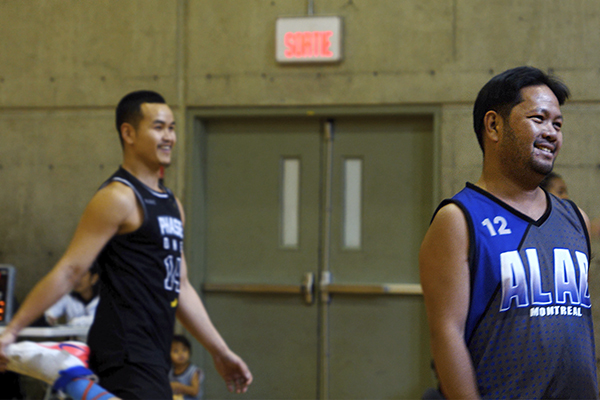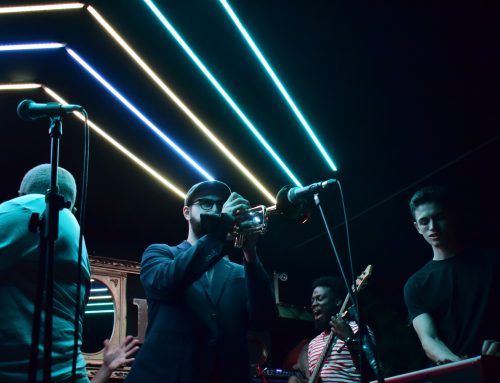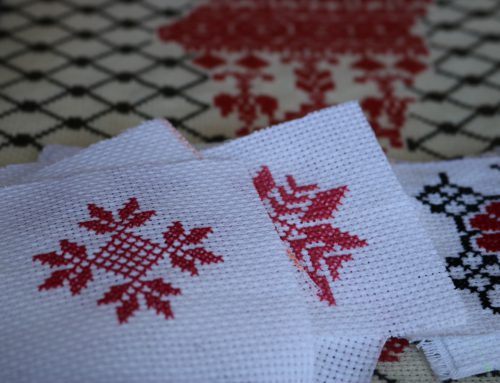BY Ian Down & Hanna Fathi
There are two minutes to play on the court and Run CDN are just barely hanging on to their lead. Just as their opponents are closing the gap, a series of successful free-throws puts them further ahead.
The basketball players are all in their 30s.
At one point, when a Run CDN player is knocked to the ground, it looks like two players are about to come to blows, but they are quickly shaking hands again.
Finally, the clock runs out. Run CDN have clinched their win. They’re not alone on the court, however: Across the gym, two adolescent teams, GIG and Banna, are on the final minutes of their match.
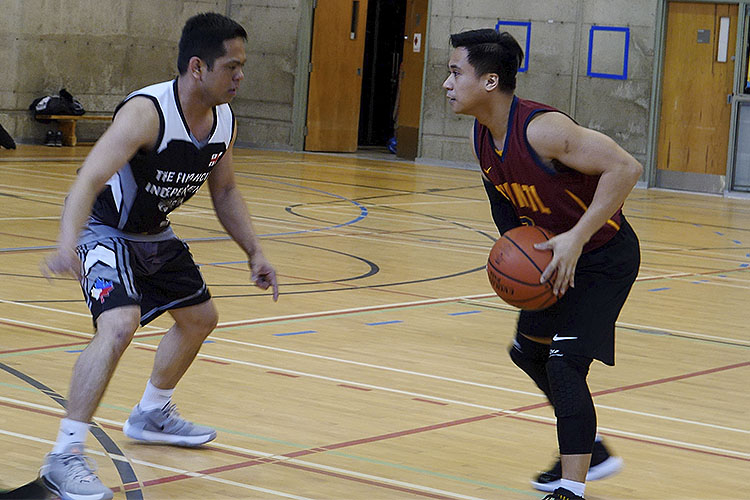
A player in the team Pousser blocks a player in Run MTL from passing to a teammate. Photo by Hanna Fathi.
It’s just another weekend in a crowded season of games for the Philippine Basketball Association of Montreal (PBAM), a league featuring dozens of teams and 600 players of all ages.
In a sitting room overlooking the courts at the Côte-des-Neiges Sports Centre, coach Jex Mendiola of GIG (“God is Good”) savours his victory. Having arrived from the Philippines two decades ago, he joined a basketball league almost right away.
“It’s my instinct,” he says. “The body is looking for a basketball.”
Still, it wasn’t easy for Mendiola to make friends with native-born Canadians.
“[There’s] this, like, should I say, gap? Maybe because of the language. But I’m talking from my own experience,” he says.
That disconnect is felt on both sides of the community. PBAM President Jose Maguigad, who was born and raised in Montreal, admits that he didn’t have any Filipino friends until he joined the league as a teenager.
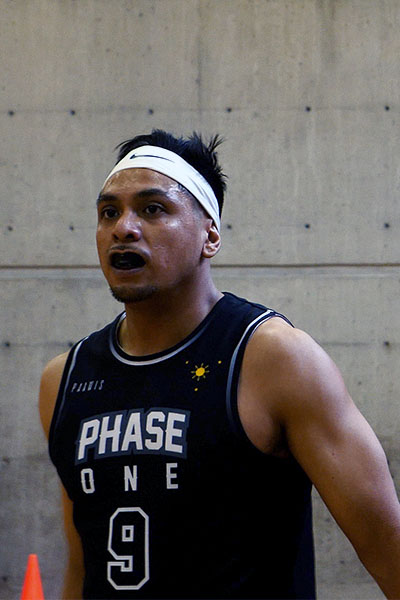
In Cote-Des-Neiges, a player of Phase One bites down on his mouthguard mid-game. His team is in the lead against their oppnents the ALAB. Photo by Hanna Fathi.
The PBAM has been in existence now for five decades. Its size and endurance are no coincidence: basketball has played a central role in Filipino culture for more than 100 years. Beyond its cultural significance, the league plays an important role in holding a community together across generational and geographic divides and through challenging economic circumstances.
“We’re particularly concerned about the second and the third generation of Filipinos,” says Alfonso Abdon, chairman of the Filipino Association of Montreal and Suburbs (FAMAS). “They don’t know much about the Philippines. They don’t know about the history of the Philippines, unless you’re forced to bring them to heritage class.”
A brief history of Filipino immigration.
Filipino migration to Canada has a relatively short but complicated history. From the late 1960s until the early 1980s, many Filipinos arrived in Canada to work as professionals. Then, in the 1980s, Canada’s need for live-in caregivers sparked a wave of domestic immigrant workers, a trend which continues to this day.
This meant many professionally-trained Filipinos coming to Canada ended up as domestic workers. “I’ve met people who are doctors, nurses, professional teachers, engineers, geologists—they’re professionals like any other professional,” says Marilou Esguerra, a parent-trainer with the Buklod Strengthening Filipino Families Program. She says, Canada’s policies “deprofessionalize Filipinos.”
From 1992 to 2014, Canada’s Live-in Caregiver Program (LCP) provided the legal framework for the employment of migrant caregivers. Under the program, workers had to live with their employer for more at least two years before being eligible for citizenship.
Research by the UQAM Service to Communities and PINAY, a local domestic workers’ rights group, found that this live-in requirement facilitated the abuse and exploitation of Montreal’s domestic workforce.
In 2015, they surveyed 33 Filipino domestic workers. They found that 26 worked at least 10 hours per day. Seven worked more than 14. In addition, more than two thirds felt they were not free to come and go from their employers’ property as they wished.
”The main effects of the live-in requirement are the absence of liberty, of a private life, and of actual rest periods,” the report concludes.
Marina Isles knows firsthand the trials of a migrant caregiver: She left the Philippines in 1990, first for France, and then Canada in 1995.
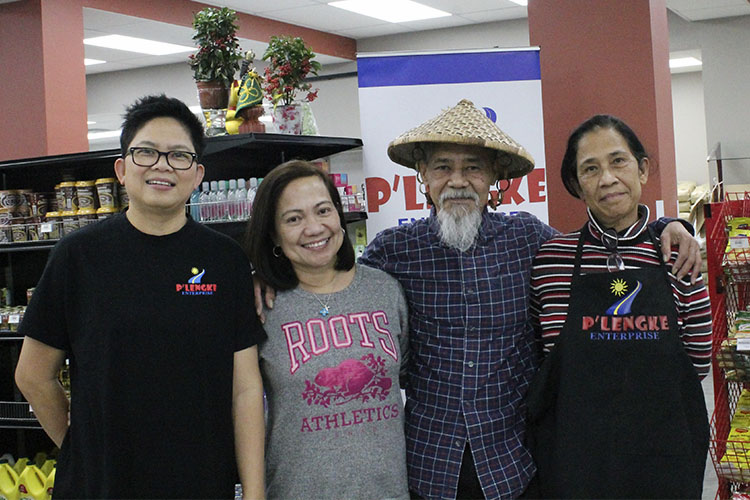
Marina Isles runs her store P’Lengke with her family, including her in-laws. Photo by Hanna Fathi.
“I came here as a caregiver, a housekeeper, and I was in the program for about two and a half years before I got my immigrant status,” she says.
She was lucky to find herself in the employ of a good family. “We built a relationship, not just employer and employee,” she says. “They’re some of my best friends now.”
But the work was never easy.
Even upon obtaining her immigrant status after two and a half years in the country, that status only brought more work.
“When I was an immigrant, I started to work at the hotels as a chambermaid, and then I worked in a restaurant too,” she says. This was on top of her work as a housekeeper. “I started my day at seven in the morning, and I finished at one in the morning.”
“Many workers have second or third jobs,” says Abdon. Because of this, he says that children are often raised primarily by babysitters. Other times, the children are sent back to the Philippines to be raised by their grandparents while their parents work in Canada.

In P’Lengke, a woman peruses the array of imported Philipino snacks. Photo by Hanna Fathi.
“That’s one of the challenges,” says Abdon. The family breaks because of the distances.”
Abdon says FAMAS’ work is aimed primarily at second and third-generation Filipinos who may not be familiar with their own culture.
“We’re here to open up and to show the tradition and the culture of the Filipinos,” he says.
In 2018, FAMAS successfully lobbied Côte-des-Neiges to declare June Filipino Heritage Month, and several celebrations and events are once again planned for this year.
With so many challenges facing the community, it’s organizations like FAMAS and PBAM that bridge the divides between Filipino Montrealers.
“When I see kids born here, I’m hesitant to talk to them, because I’m shy,” says Mendiola of his arrival in Montreal. “But when we start playing basketball, it develops a friendship, a camaraderie, and it started to remove that gap in between [us] inside the court.”
Meet the players of The Philippine Basketball Association of Montreal (PBAM) league. Video by Hanna Faithi.
Isles first connected with other Filipinos in Montreal by enrolling in a class at the FAMAS centre. “I started one of the programs there, and then I connected with friends, and then I started to meet people from my hometown.”
Community organizations like the PBAM and FAMAS do have their limitations. Not everyone is brought into the fold by their activities. Women, especially, are often unable to attend many events.
“Because of their needs for financial stability, they often need to work three or four jobs to be able to sustain their family’s needs,” says Evelyn Calugay of Pinay. “It’s very difficult to juggle their time. They may have time to do this, but not on a regular basis.”
Basketball is not the only way for second and third-generation Filipinos to connect with their culture. Isles now owns a Filipino grocery store in Côte-des-Neiges called Plengke.
“The aim of Plengke is to bring our co-Filipino here in Montreal close to home,” she says. “The people who were born in the Philippines, when they come here, they see those products that we brought here [from the Philippines], so they’re happy. They feel at home. Then, the parents of the kids that were born here, they bring their kids, and they introduce those items.
“They say, you know, ‘Your grandmother used to cook this; Have a taste, and it will bring you home.’”
